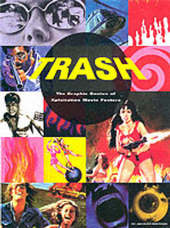
|
Trash: The Graphic Genius of Xploitation Movie Poster Art
Paperback / softback
Main Details
| Title |
Trash: The Graphic Genius of Xploitation Movie Poster Art
|
| Authors and Contributors |
By (author) Jacques Boyreau
|
| Physical Properties |
| Format:Paperback / softback | | Pages:144 | | Dimensions(mm): Height 305,Width 230 |
|
| Category/Genre | Graphic design
Poster art
Films and cinema |
|---|
| ISBN/Barcode |
9780811834179
|
| Classifications | Dewey:769.4979143 |
|---|
| Audience | |
|---|
| Illustrations |
chiefly facsimiles (chiefly colour)
|
|
Publishing Details |
| Publisher |
Chronicle Books
|
| Imprint |
Chronicle Books
|
| Publication Date |
20 June 2002 |
| Publication Country |
United States
|
Description
Trash: The Graphic Genius of Xploitation Movie Poster Art proudly assembles more than 150 masterpieces of twisted brilliance: lowbrow graphic poster art from the sickest, sleaziest, sexiest, and weirdest films from the 1950s through the 1980s. Most poster art and film poster surveys focus on design, composition, and vintage wonder. Trash rolls in the mud with graphic art of such questionable (social) quality that it practically redefines the poster as advertising medium. Chapters each define a key trash topic (Sex Trash, Action Trash, Sick Trash, Race Trash, Groovy Trash, and Docu Trash), collecting the funniest, most disturbing, and desperate posters from each genre. Short introductions set the tone, offer eye-opening context, and then just get out of the way to let the posters themselves run riot on the page. Thrill to unfortunate star turns, plagues of frogs, meteors headed straight for earth, sex-starved zombies, and explosion after explosion. Includes jaw-dropping vintage ad mats (ads as they ran in newspapers, Astro Zombies cheek-by-jowl with The Godfather) and promotional materials (salacious sell kits given to theater owners to reel in customers). One glance at the bold and astonishing artwork convinces.
Author Biography
Jacques Boyreau co-founded the half-bar, half-underground cinema known as the Werepad. His archive, Cosmic Hex, contains hundreds of cult, horror, and sci-fi films, as well as thousands of movie posters. He lives in San Francisco.
ReviewsThe saying oges that one man's trash is another's treasure. Then there's "Trash," a treasure chest of exploitation movie poster art assembled by Jacques Boyreau and published by Chronicle Books ($19.95). You don't have to have seen the movies to enjoy the gaudy graphics and pure bad taste in "Trash"; if you've seen more than a handful of them, you might want to seek professional help. You don't even have to know what an exploitation movies is (loosely defined, it's a cheaply made movie that addresses a hot topic with reckless abandon). Just bring a dark sense of humor and an appreciation for kitsch. Many of the posters in "Trash" may make you laugh and cringe at the same time. Take the poster for "Corruption" (1968). The color art shows three corpses lying in a bedroom with smoke streaming in from the edges. Then there's the ad copy, scrawled in what looks like black and red crayon: "Corruption is not a woman's picture! Therefore: No Woman Will Be Admitted Alone To See This Super-Shock Film!!" It's sexism and violence all rolled into one, the epitome of trash marketing. Of course the more blatant sexploitation came in the form of large-breasted she-killers. "Hustler Squad" (1976) certainly owed a debt to Russ Meyer. The poster shows a bevy of buxom, barely dressed women pumping lead into their male adversaries. "Professionals...You Pay For The Pleasure, The Killing Is Free!" reads the copy. Like the current movie marketing departments that quote "critics," trash posters had a real thing for exclamation points. And no exploitation display would be complete without blaxploitation, the genre that helped lift Hollywood out of deep financial crisis in the early '70s. Blaxploitation was so big that it even crossed over to Mexico: The poster for "El Salvaje Negro" shows a black man dressed in black with an orange poncho, blasting a flame-thrower into the air as - guess who? - buxom beauties fire their machine guns in the background. As offensive as you may find them, such posters now serve as telling artifacts from a time when political correctness wasn't yet on the radar. They also contain a surprising number of big and at least somewhat reputable names: Al Pacino ("The Panic in Needle Park"), Quincy Jones ("Honky"), Jackie Gleason ("Skidoo"), Boris Karloff ("The Sorcerers") and Southfork's own Larry Hagman ("Son of Blob") are all present and accounted for, even if they'd rather that you didn't know. Rest assured that they all got paid, because money was ultimately what exploitation movies were all about. Cheap thrills ahve always made long green. If you need a contemporary reminder, just watch reality TV. -The Dallas Morning News Boyreau, co-owner of San Francisco's Weredpad, an underground movie theater/cinema archive, has edited together a coffee table edition that reprints and notates more than 150 of the loudest, gaudiest and cheapest-looking movie posters ever created. Covering pulp cinema from the '50s all the way to the '80s, these outlandish one-sheets represent a cross-section of art from the "trashiest" films ever created. The collection revels in all kinds of alternative cinema, from zombie gore-fests to scantily clad women's prison movies - from nuns in biker gangs to the scientific horrow of oversized bugs. Depending on your point of view, "Trash" is either a celebration of the visceral power of baroque popular culture or an indictment of raunchy forms of media that play to the lowest common denominator. Either way, you can't tear your eyes away from it. -Cinescape
|